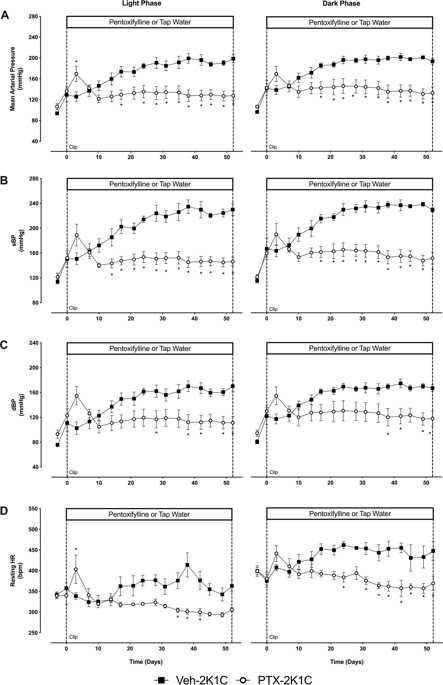当前位置:
X-MOL 学术
›
Hypertens. Res.
›
论文详情
Our official English website, www.x-mol.net, welcomes your
feedback! (Note: you will need to create a separate account there.)
Systemic administration of pentoxifylline attenuates the development of hypertension in renovascular hypertensive rats
Hypertension Research ( IF 4.3 ) Pub Date : 2020-02-14 , DOI: 10.1038/s41440-020-0412-6 Anthony Setiadi 1 , Willian S Korim 1 , Clive N May 1 , Song T Yao 1, 2
Hypertension Research ( IF 4.3 ) Pub Date : 2020-02-14 , DOI: 10.1038/s41440-020-0412-6 Anthony Setiadi 1 , Willian S Korim 1 , Clive N May 1 , Song T Yao 1, 2
Affiliation

|
There is evidence to suggest that hypertension involves a chronic low-grade systemic inflammatory response; however, the underlying mechanisms are unclear. To further understand the role of inflammation in hypertension, we used a rat renovascular model of hypertension in which we administered the TNF-α synthesis inhibitor pentoxifylline (PTX, 30 mg/kg/day) in the drinking water for 60 days. In conscious rats, PTX administration significantly attenuated the development of hypertension (systolic blood pressure, PTX: 145 ± 8 vs. vehicle (Veh): 235 ± 11 mmHg, after 38 days of treatment, P < 0.05, N = 5/group). This attenuation in hypertension was coupled with a decrease in the low-frequency spectra of systolic blood pressure variability (PTX: 1.23 ± 0.2 vs Veh: 3.05 ± 0.8 arbitrary units, P < 0.05, N = 5/group). Furthermore, systemic PTX administration decreased c-Fos expression within the hypothalamic paraventricular nucleus (PTX: 17 ± 4 vs. Veh: 70 ± 13 cells, P < 0.01, N = 5, PVN) and increased the total number of microglial branches (PTX: 2129 ± 242 vs. Veh: 1415 ± 227 branches, P < 0.05, N = 4/group). Acute central injection of PTX (20 μg) under urethane anesthesia caused a small transient decrease in blood pressure but did not change renal sympathetic nerve activity. Surprisingly, we found no detectable basal levels of plasma TNF-α in either PTX- or vehicle-treated animals. These results suggest that inflammation plays a role in renovascular hypertension and that PTX might act both peripherally and centrally to prevent hypertension.
中文翻译:

己酮可可碱的全身给药减弱了肾血管性高血压大鼠高血压的发展
有证据表明,高血压涉及慢性低度全身炎症反应;然而,潜在的机制尚不清楚。为了进一步了解炎症在高血压中的作用,我们使用了高血压大鼠肾血管模型,在该模型中,我们在饮用水中施用 TNF-α 合成抑制剂己酮可可碱(PTX,30 毫克/千克/天)60 天。在清醒的大鼠中,PTX 给药显着减弱了高血压的发展(收缩压,PTX:145 ± 8 与载体(Veh):235 ± 11 mmHg,治疗 38 天后,P < 0.05,N = 5/组) . 高血压的这种减弱伴随着收缩压变异性的低频频谱的降低(PTX:1.23 ± 0.2 vs Veh:3.05 ± 0.8 任意单位,P < 0.05,N = 5/组)。此外,全身性 PTX 给药降低了下丘脑室旁核内的 c-Fos 表达(PTX:17 ± 4 与 Veh:70 ± 13 个细胞,P < 0.01,N = 5,PVN)并增加了小胶质细胞分支的总数(PTX:2129 ± 242 vs. Veh:1415 ± 227 个分支,P < 0.05,N = 4/组)。在氨基甲酸乙酯麻醉下急性中枢注射 PTX (20 μg) 引起血压短暂的小幅下降,但没有改变肾交感神经活动。令人惊讶的是,我们发现在 PTX 或载体处理的动物中没有可检测到的血浆 TNF-α 基础水平。这些结果表明炎症在肾血管性高血压中起作用,并且 PTX 可能在外周和中枢上起到预防高血压的作用。0.01,N = 5,PVN)并增加小胶质细胞分支的总数(PTX:2129 ± 242 vs. Veh:1415 ± 227 分支,P < 0.05,N = 4/组)。在氨基甲酸乙酯麻醉下急性中枢注射 PTX (20 μg) 引起血压短暂的小幅下降,但没有改变肾交感神经活动。令人惊讶的是,我们发现在 PTX 或载体处理的动物中没有可检测到的血浆 TNF-α 基础水平。这些结果表明炎症在肾血管性高血压中起作用,并且 PTX 可能在外周和中枢上起到预防高血压的作用。0.01,N = 5,PVN)并增加小胶质细胞分支的总数(PTX:2129 ± 242 vs. Veh:1415 ± 227 分支,P < 0.05,N = 4/组)。在氨基甲酸乙酯麻醉下急性中枢注射 PTX (20 μg) 引起血压短暂的小幅下降,但没有改变肾交感神经活动。令人惊讶的是,我们发现在 PTX 或载体处理的动物中没有可检测到的血浆 TNF-α 基础水平。这些结果表明炎症在肾血管性高血压中起作用,并且 PTX 可能在外周和中枢上起到预防高血压的作用。在氨基甲酸乙酯麻醉下急性中枢注射 PTX (20 μg) 引起血压短暂的小幅下降,但没有改变肾交感神经活动。令人惊讶的是,我们发现在 PTX 或载体处理的动物中没有可检测到的血浆 TNF-α 基础水平。这些结果表明炎症在肾血管性高血压中起作用,并且 PTX 可能在外周和中枢上起到预防高血压的作用。在氨基甲酸乙酯麻醉下急性中枢注射 PTX (20 μg) 引起血压短暂的小幅下降,但没有改变肾交感神经活动。令人惊讶的是,我们发现在 PTX 或载体处理的动物中没有可检测到的血浆 TNF-α 基础水平。这些结果表明炎症在肾血管性高血压中起作用,并且 PTX 可能在外周和中枢上起到预防高血压的作用。
更新日期:2020-02-14
中文翻译:

己酮可可碱的全身给药减弱了肾血管性高血压大鼠高血压的发展
有证据表明,高血压涉及慢性低度全身炎症反应;然而,潜在的机制尚不清楚。为了进一步了解炎症在高血压中的作用,我们使用了高血压大鼠肾血管模型,在该模型中,我们在饮用水中施用 TNF-α 合成抑制剂己酮可可碱(PTX,30 毫克/千克/天)60 天。在清醒的大鼠中,PTX 给药显着减弱了高血压的发展(收缩压,PTX:145 ± 8 与载体(Veh):235 ± 11 mmHg,治疗 38 天后,P < 0.05,N = 5/组) . 高血压的这种减弱伴随着收缩压变异性的低频频谱的降低(PTX:1.23 ± 0.2 vs Veh:3.05 ± 0.8 任意单位,P < 0.05,N = 5/组)。此外,全身性 PTX 给药降低了下丘脑室旁核内的 c-Fos 表达(PTX:17 ± 4 与 Veh:70 ± 13 个细胞,P < 0.01,N = 5,PVN)并增加了小胶质细胞分支的总数(PTX:2129 ± 242 vs. Veh:1415 ± 227 个分支,P < 0.05,N = 4/组)。在氨基甲酸乙酯麻醉下急性中枢注射 PTX (20 μg) 引起血压短暂的小幅下降,但没有改变肾交感神经活动。令人惊讶的是,我们发现在 PTX 或载体处理的动物中没有可检测到的血浆 TNF-α 基础水平。这些结果表明炎症在肾血管性高血压中起作用,并且 PTX 可能在外周和中枢上起到预防高血压的作用。0.01,N = 5,PVN)并增加小胶质细胞分支的总数(PTX:2129 ± 242 vs. Veh:1415 ± 227 分支,P < 0.05,N = 4/组)。在氨基甲酸乙酯麻醉下急性中枢注射 PTX (20 μg) 引起血压短暂的小幅下降,但没有改变肾交感神经活动。令人惊讶的是,我们发现在 PTX 或载体处理的动物中没有可检测到的血浆 TNF-α 基础水平。这些结果表明炎症在肾血管性高血压中起作用,并且 PTX 可能在外周和中枢上起到预防高血压的作用。0.01,N = 5,PVN)并增加小胶质细胞分支的总数(PTX:2129 ± 242 vs. Veh:1415 ± 227 分支,P < 0.05,N = 4/组)。在氨基甲酸乙酯麻醉下急性中枢注射 PTX (20 μg) 引起血压短暂的小幅下降,但没有改变肾交感神经活动。令人惊讶的是,我们发现在 PTX 或载体处理的动物中没有可检测到的血浆 TNF-α 基础水平。这些结果表明炎症在肾血管性高血压中起作用,并且 PTX 可能在外周和中枢上起到预防高血压的作用。在氨基甲酸乙酯麻醉下急性中枢注射 PTX (20 μg) 引起血压短暂的小幅下降,但没有改变肾交感神经活动。令人惊讶的是,我们发现在 PTX 或载体处理的动物中没有可检测到的血浆 TNF-α 基础水平。这些结果表明炎症在肾血管性高血压中起作用,并且 PTX 可能在外周和中枢上起到预防高血压的作用。在氨基甲酸乙酯麻醉下急性中枢注射 PTX (20 μg) 引起血压短暂的小幅下降,但没有改变肾交感神经活动。令人惊讶的是,我们发现在 PTX 或载体处理的动物中没有可检测到的血浆 TNF-α 基础水平。这些结果表明炎症在肾血管性高血压中起作用,并且 PTX 可能在外周和中枢上起到预防高血压的作用。











































 京公网安备 11010802027423号
京公网安备 11010802027423号